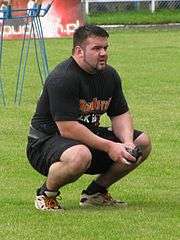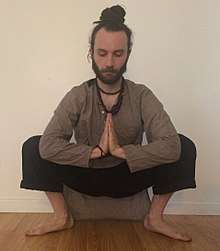Squatting position
Squatting is a versatile posture where the weight of the body is on the feet but the knees and hips are bent. In contrast, sitting involves taking the weight of the body, at least in part, on the buttocks against the ground or a horizontal object. The angle between the legs when squatting can vary from zero to widely splayed out, flexibility permitting. Another variable may be the degree of forward tilt of the upper body from the hips. Squatting may be either full or partial.
Crouching is usually considered to be synonymous with squatting. It is common to squat with one leg and kneel with the other leg.[1] One or both heels may be up when squatting. Young children often instinctively squat. Among Chinese, Southeast Asian and Eastern European adults, squatting often takes the place of sitting or standing.[2]
Etymology
As a verb – early 15th century. Squatting in the sense of "crouch on the heels" is from the Old French words esquatir/escatir. Squatting in the sense of "compress, press down, lay flat, crush" is from about 1400. Meaning "posture of one who squats" is from 1570s. Act of squatting is from 1580s. Weight-lifting sense is from 1954.[3]
Resting position

Full squatting involves resting one's weight on the feet with the buttocks resting on the backs of the calves. It may be used as a posture for resting or working at ground level particularly where the ground is too dirty or wet to sit or kneel.[1]
Most Western adults cannot place their heels flat on the ground when squatting because of shortened Achilles tendons maybe caused by habit:[4][5][6]
- sitting on chairs or seats
- wearing shoes with heels (especially high heels)
For this reason the squatting position is usually not sustainable for them for more than a few minutes as heels-up squatting is a less stable position than heels-down squatting.[7][8] See also dorsiflexion.
Equivalents to the Slav squat (see Gopnik) in Western culture, sometimes with the hands together in a prayer position, are the rap squat, prison pose, and jail pose. They are often used as photographic poses.[9][10][11]
Dynamic exercise
In strength training, the squat is a full body exercise that trains primarily the muscles of the thighs, hips and buttocks, as well as strengthening the bones, ligaments and insertion of the tendons throughout the lower body. Squats are considered a vital exercise for increasing the strength and size of the legs and buttocks.
The pistols squat is a one legged squat common in crossfit exercises in which the non-working leg is kept horizontal.
The burpee is a full body exercise used in strength training and as an aerobic exercise that involves a squat. The basic movement is performed in four steps and known as a "four-count burpee".
In Taoist Tai Chi, the "Dan Yu" (spine stretching) exercise involves squatting. It is intended to work primarily the pelvic region, the legs and the lower back. Fifty or more repetitions may be performed in advanced classes. The feet are placed in a stance wider than the shoulders. When squatting the knees move in the direction of the feet.[12][13][14]
Childbirth position
Various people have promoted the adoption of these alternative birthing positions, particularly squatting, for Western countries, such as Grantly Dick-Read, Janet Balaskas, Moysés Paciornik and Hugo Sabatino. The adoption of these alternative positions is also promoted by the natural childbirth movement.
The squatting position gives a greater increase of pressure in the pelvic cavity with minimal muscular effort. The birth canal will open 20 to 30% more in a squat than in any other position. It is recommended for the second stage of childbirth.[15]
In ancient Egypt, women delivered babies while squatting on a pair of bricks, known as birth bricks.[16]
Sexual position
There are versions of the "cowgirl" sex position where the woman is squatting over the man, who is lying on his back, instead of kneeling over him. These are referred to by different names such as Asian cowgirl, frog squat position, and froggystyle.[17] The woman can face forwards[18] or backwards (reverse).[19]
Urinating and defecating
When not urinating into a toilet, squatting is the easiest way for a woman to direct the urine stream. If done this way, the urine will go forward. Some females use one or both hands to focus the direction of the urine stream, which is more easily achieved while in the squatting position. It is also possible for females to urinate while standing, and while clothed.[20]
A partial squatting position (or "hovering") while urinating is often done to avoid sitting on a potentially contaminated toilet seat, but it may leave urine behind in the bladder[21] and it is not good for the pelvic floor.[22]
The squatting defecation posture involves squatting by standing with the knees and hips sharply bent and the bare buttocks suspended near the ground. Squat toilets are designed to facilitate this posture and are common in various parts of the world.
Mālāsana or upavesasana in yoga
Mālāsana (literally sitting down pose), also known as the yoga squat, is an asana.[23]
The asana is a squat with heels flat on the floor and hip-width apart (or slightly wider if necessary), toes pointing out on a diagonal. The torso is brought forward between the thighs, elbows are braced against the inside of the knees, and the hands press together in front of the chest in Añjali Mudrā.[24]
Disease
Risk of osteoarthritis
There is increased incidence of knee osteoarthritis among squatters who squat for hours a day for many years.[25] There is evidence that sustained squatting may cause bilateral peroneal nerve palsy. A common name for this affliction is squatter's palsy although there may be reasons other than squatting for this to occur.[26][27][28] For richer societies who rarely squat, squatting as a different posture may bring health benefits.[29]
A sign of Tetralogy of Fallot
Older children will often squat during a Tetralogy of Fallot "tet spell". This increases systemic vascular resistance and allows for a temporary reversal of the shunt. It increases pressure on the left side of the heart, decreasing the right to left shunt thus decreasing the amount of deoxygenated blood entering the systemic circulation.[30][31]
Squatting facets
The existence of squatting facets on the distal tibia and talar articular surfaces of skeletons, which result from contact between the two bones during hyperdorsiflexion, have been used as markers to indicate if that person habitually squatted.[32][33]
See also
- Denis Parsons Burkitt
- Di nixi
- Gopnik - a practitioner of a learned behavior attributed to Russian prison culture to avoid sitting on the cold ground
- Human positions
- Hunky punk
- Lajja Gauri
- Messenger (Plymouth sculpture)
- Neutral spine – "three natural curves [that] are present in a healthy spine."
References
- Hewes, GW (April 1955). "World distribution of certain postural habits". American Anthropologist. 57 (2): 231–44. doi:10.1525/aa.1955.57.2.02a00040. JSTOR 666393.
- Dobrzynski, Judith H. (17 October 2004). "An Eye on China's Not So Rich and Famous". The New York Times. Retrieved 7 April 2010.
- "squat | Origin and meaning of squat by Online Etymology Dictionary". www.etymonline.com.
- Kasuyama, Tatsuya, Masaaki Sakamoto, and Rie Nakazawa. "Ankle Joint Dorsiflexion Measurement Using the Deep Squatting Posture." Journal of Physical Therapy Science 21.2 (2009): 195–99.
- Krause DA, Cloud BA, Forster LA, Schrank JA, Hollman JH. "Measurement of ankle dorsiflexion: a comparison of active and passive techniques in multiple positions". Journal of Sport Rehabilitation 2011 Aug; 20(3): 333–44.
- Ausinheiler B The number 1 reason why people find deep squatting difficult 27 November 2012
- Mauss, Marcel. Les Techniques du corps 1934. Journal de Psychologie 32 (3–4). Reprinted in Mauss, Sociologie et anthropologie, 1936, Paris: PUF.
- Bookspan, Jolie. "Save knees when squatting". Healthline.com. Retrieved 24 November 2013.
- Love D Russia totally reinvented the rap squat? The Daily Dot 24 Jun 2015
- Millard, Drew (27 December 2013). "Everything You Ever Wanted to Know About Rap Squats but Were Afraid to Ask".
- Cabatingan L Trend Alert: Gang Signs are Out, Rap Squats Are In IX Daily 15 September 2014
- Yang Chengfu (1931), Taijiquan Shiyongfa (Application methods of Taijiquan)
- Yang Chengfu (1934), Taijiquan Tiyong Quanshu (Complete Book of the Essence and Applications of Taijiquan)
- Yang Chengfu and Louis Swaim, tr. (2005). The Essence and Applications of Taijiquan. North Atlantic Books. ISBN 978-1-55643-545-4.
- Russell, JG (1969). "Moulding of the pelvic outlet". J Obstet Gynaecol Br Commonw. 76: 817–20.
- Wilkinson, Richard H. (2003). The complete gods and goddesses of ancient Egypt. London: Thames & Hudson. pp. 152–53. ISBN 978-0-500-05120-7.
- "Discovery Health Sexual Positions". healthguide.howstuffworks.com. Retrieved 22 October 2010.
- Asian Cowgirl Sex Position Sexinfo101.com
- Reverse Asian Cowgirl Sex Position Sexinfo101.com
- "A Woman's Guide on How to Pee Standing". Archived from the original on 4 June 2003.
- "Kidney infection – Treatment". nhs.uk. National Health Service. 4 January 2018. Retrieved 21 February 2019.
If you have a kidney infection, try not to "hover" over the toilet seat when you go to the loo because it can result in your bladder not being fully emptied.
- "5 Bathroom Mistakes That Can Lead To Pelvic Floor Dysfunction". HuffPost Canadian version. 21 July 2016. Retrieved 21 February 2019.
Hovering Over The Toilet
- "5 Yoga Tips to Open Up the Hips".
- "Garland Pose". Yoga Journal. Retrieved 12 June 2009.
- Liu CM, Xu L (2007). "Retrospective study of squatting with prevalence of knee osteoarthritis"Template:ISSN missing
- Macpherson JM, Gordon AJ (1983). "Squatter's palsy" British Medical Journal
- Kumaki DJ. "The facts of Kathmandu: squatter's palsy". Journal of the American Medical Association 2 January 1987; 257(1): 28.
- Toğrol, E. (2000). "Bilateral peroneal nerve palsy induced by prolonged squatting". Military Medicine. 165 (3): 240–2. PMID 10741091.
- Spinks, Rosie (9 November 2017). "The forgotten art of squatting is a revelation for bodies ruined by sitting". Quartz (publication). Retrieved 14 November 2017.
- Murakami T (2002). "Squatting: the hemodynamic change is induced by enhanced aortic wave reflection". Am. J. Hypertens. 15 (11): 986–88. doi:10.1016/S0895-7061(02)03085-6. PMID 12441219.
- Guntheroth WG, Mortan BC, Mullins GL, Baum D. Am "Venous return with knee-chest position and squatting in tetralogy of Fallot". Heart J. 1968 Mar; 75(3): 313–18.
- Barnett CH "Squatting facets on the European talus" J Anat. 1954 October; 88 (Pt 4): 509–13.
- Trinkaus E "Squatting among the neandertals: A problem in the behavioral interpretation of skeletal morphology" Journal of Archaeological Science Volume 2, Issue 4, December 1975, pp. 327–51
External links
| Wikimedia Commons has media related to |
